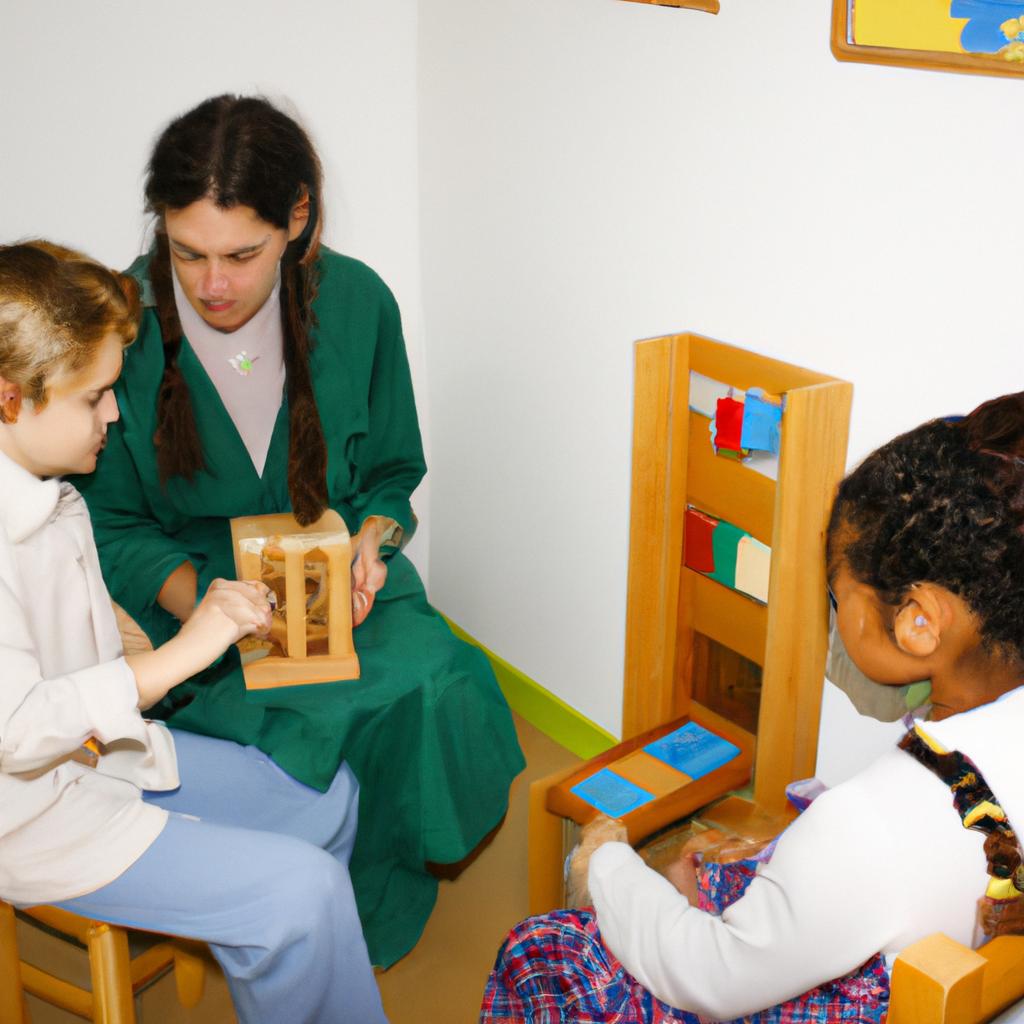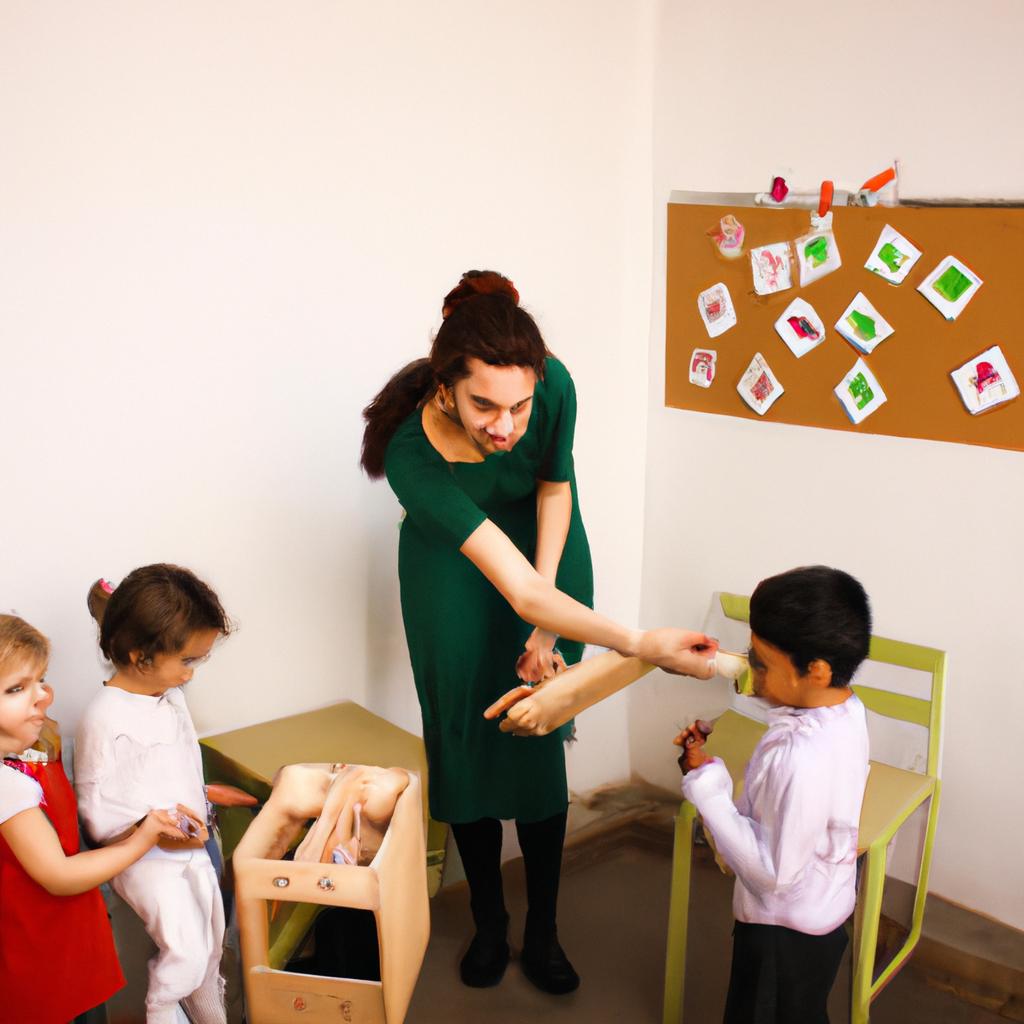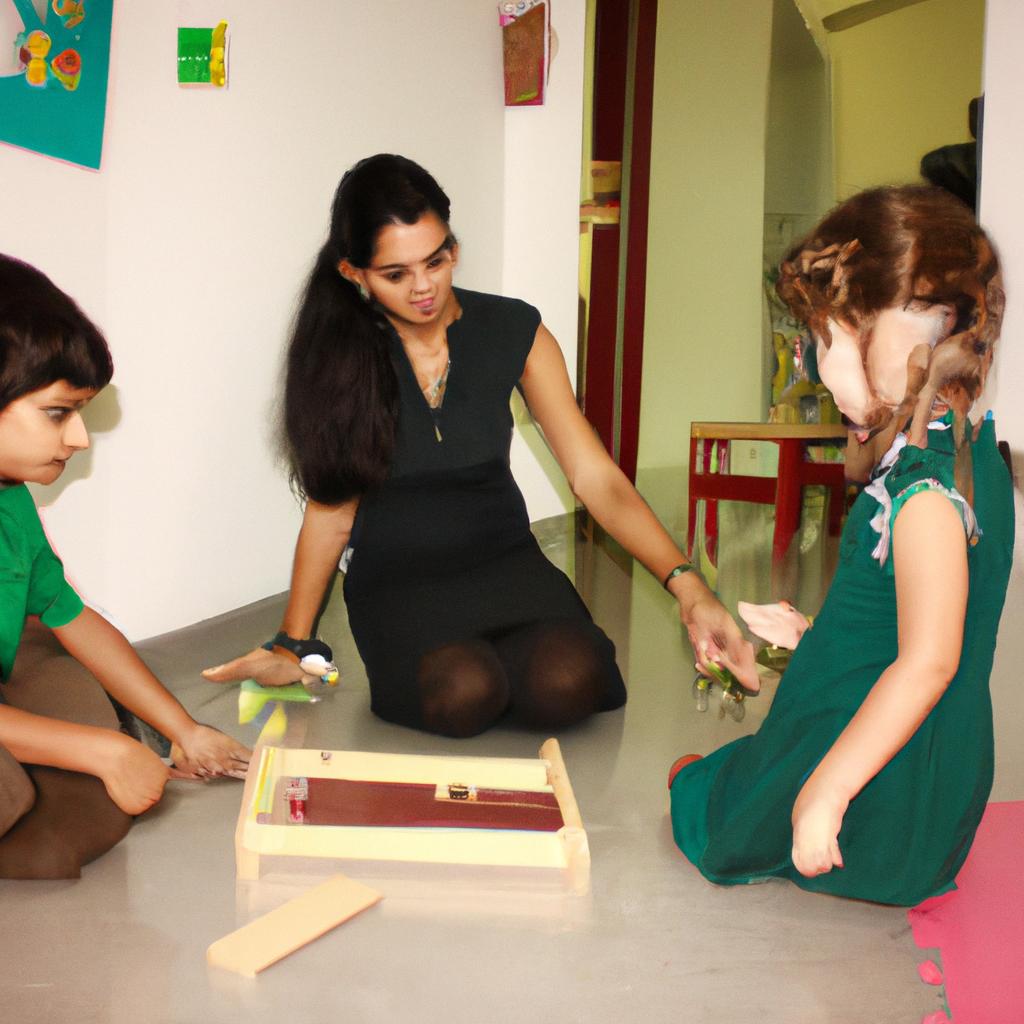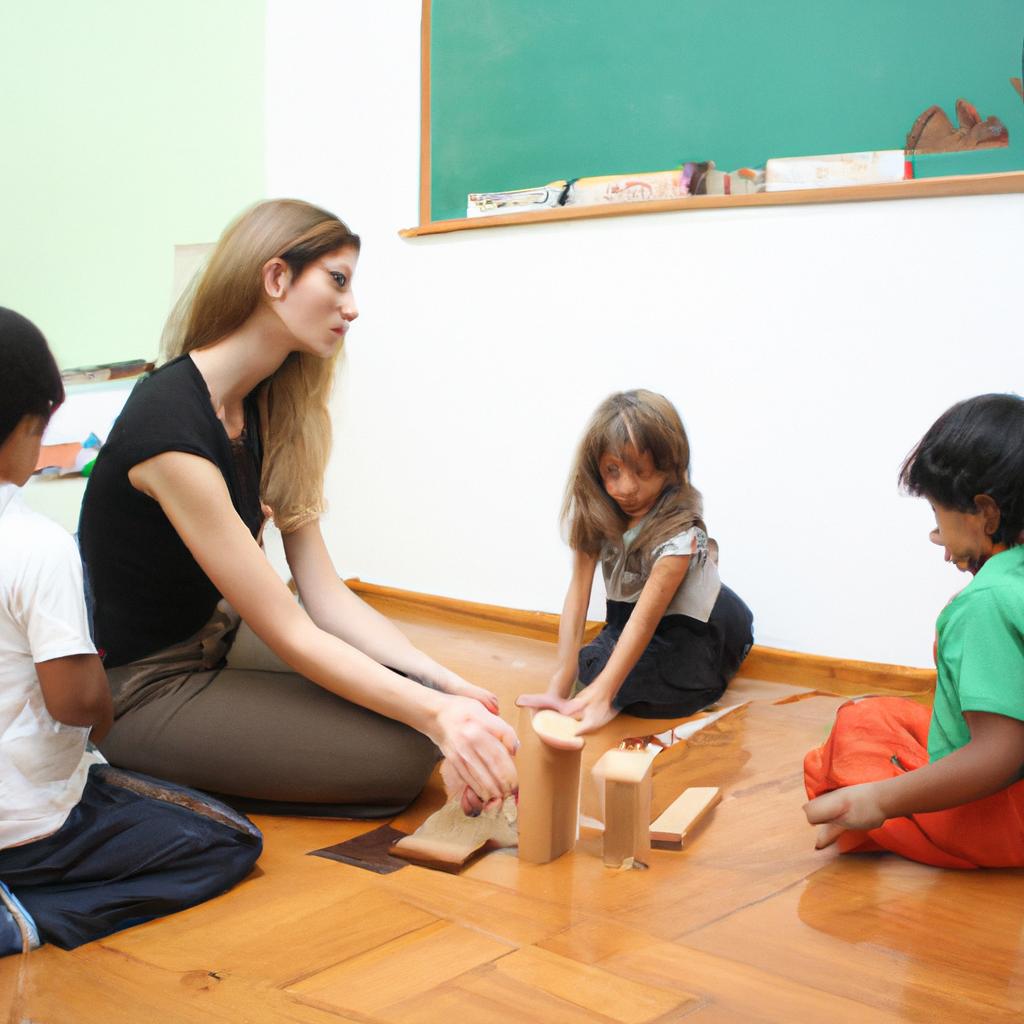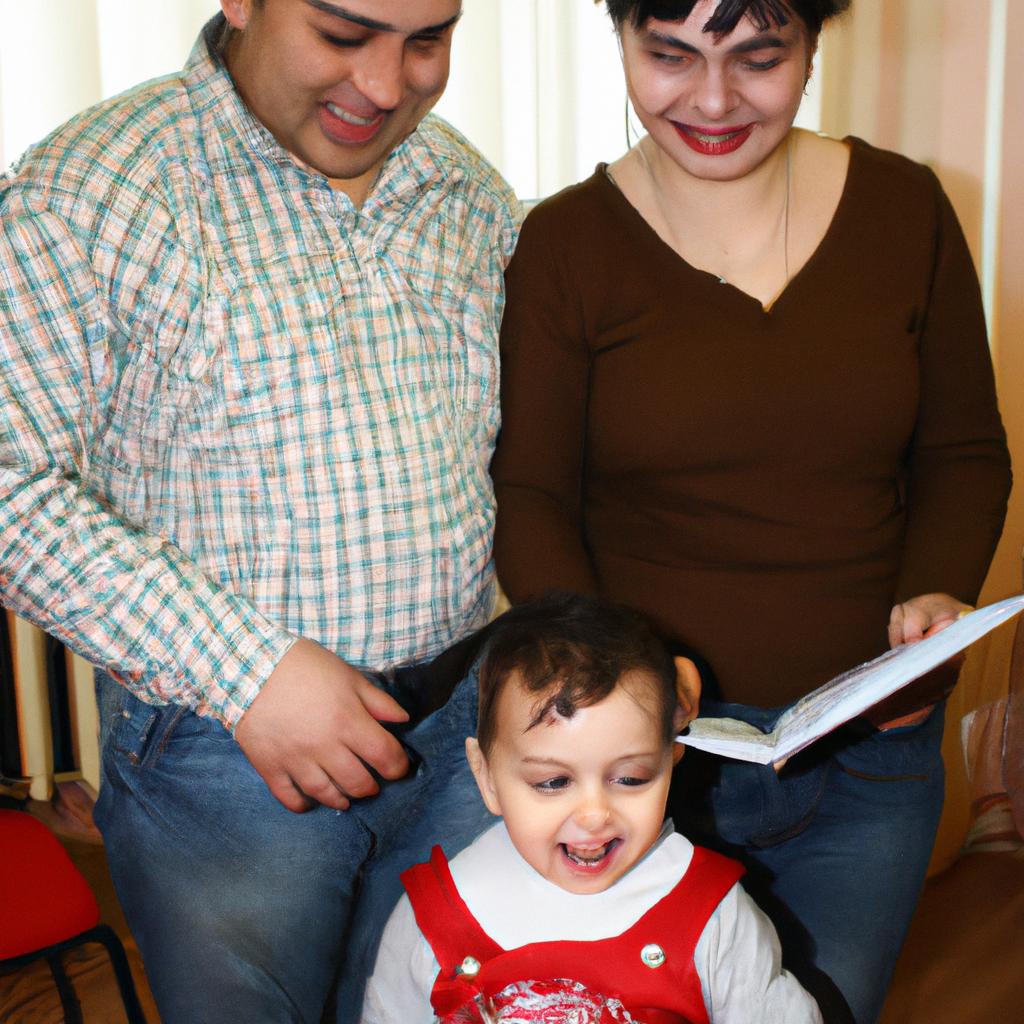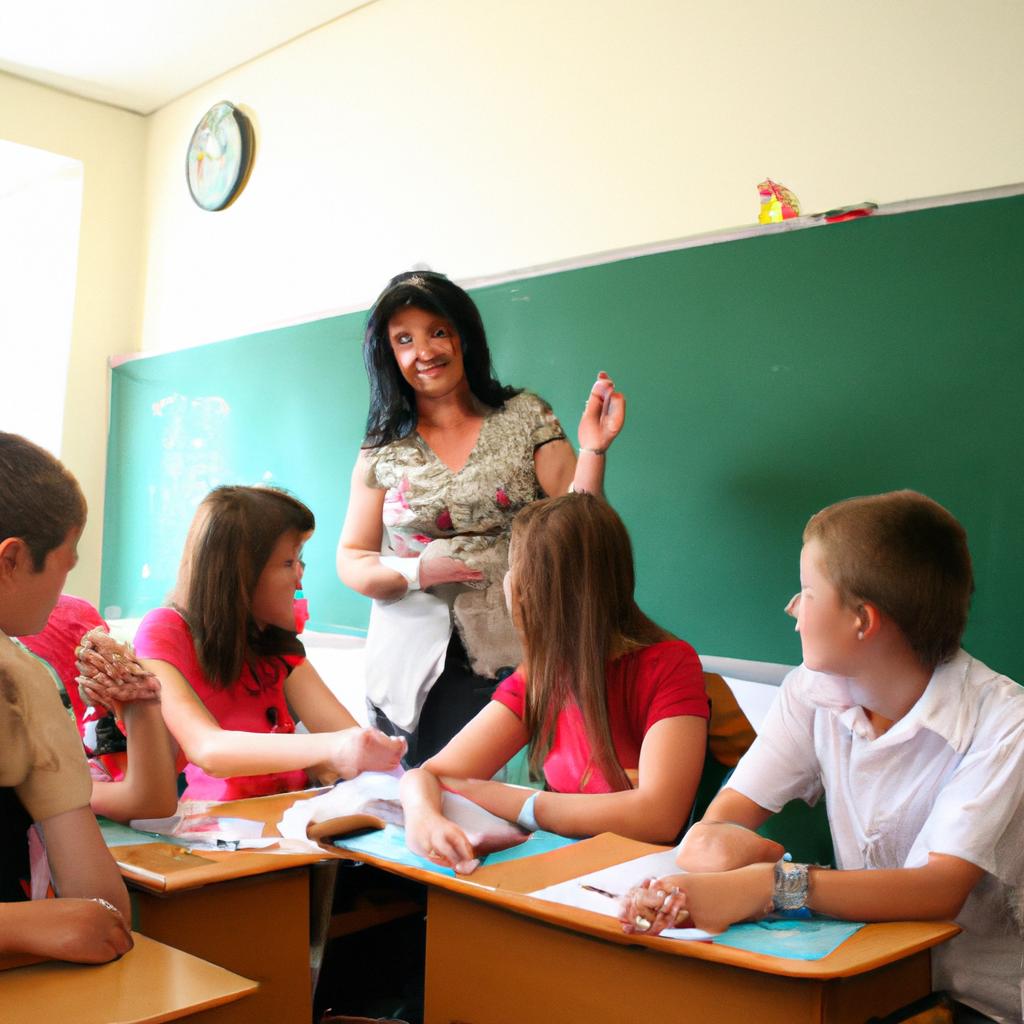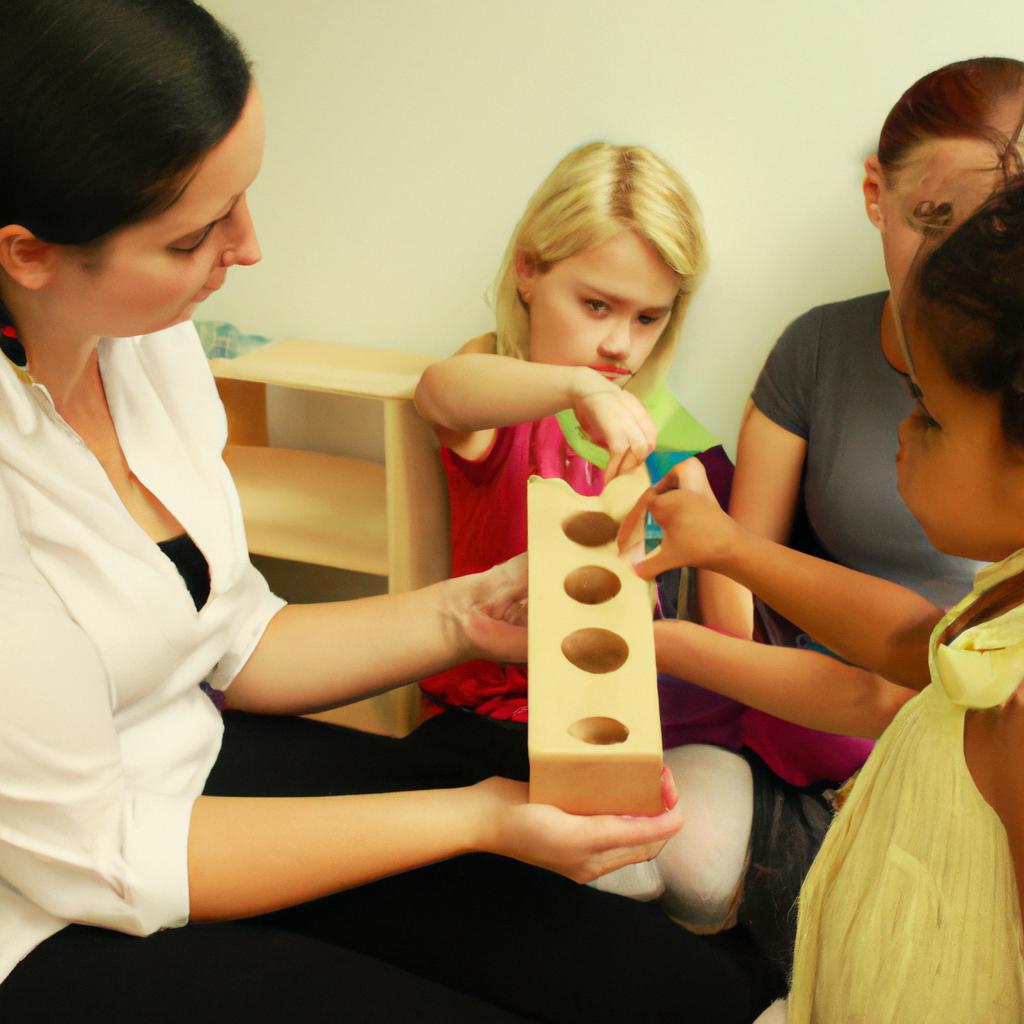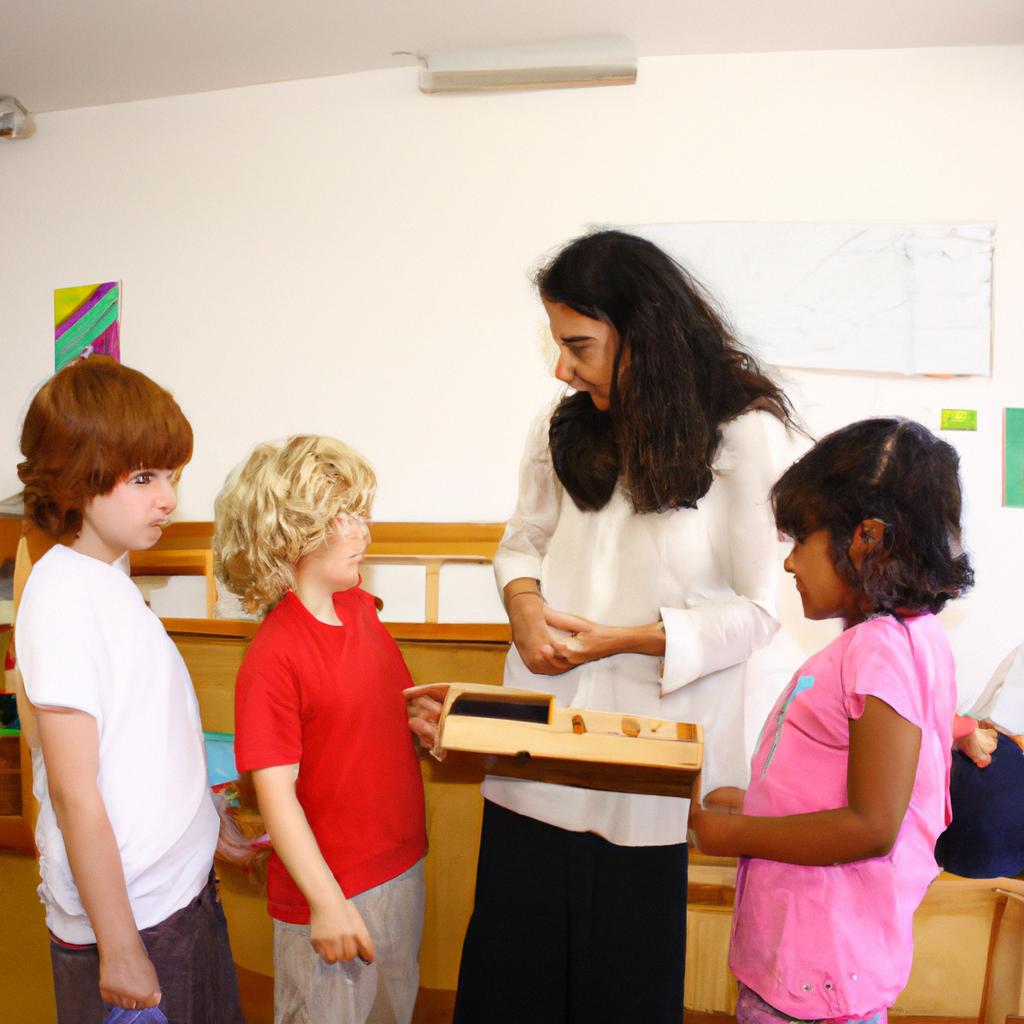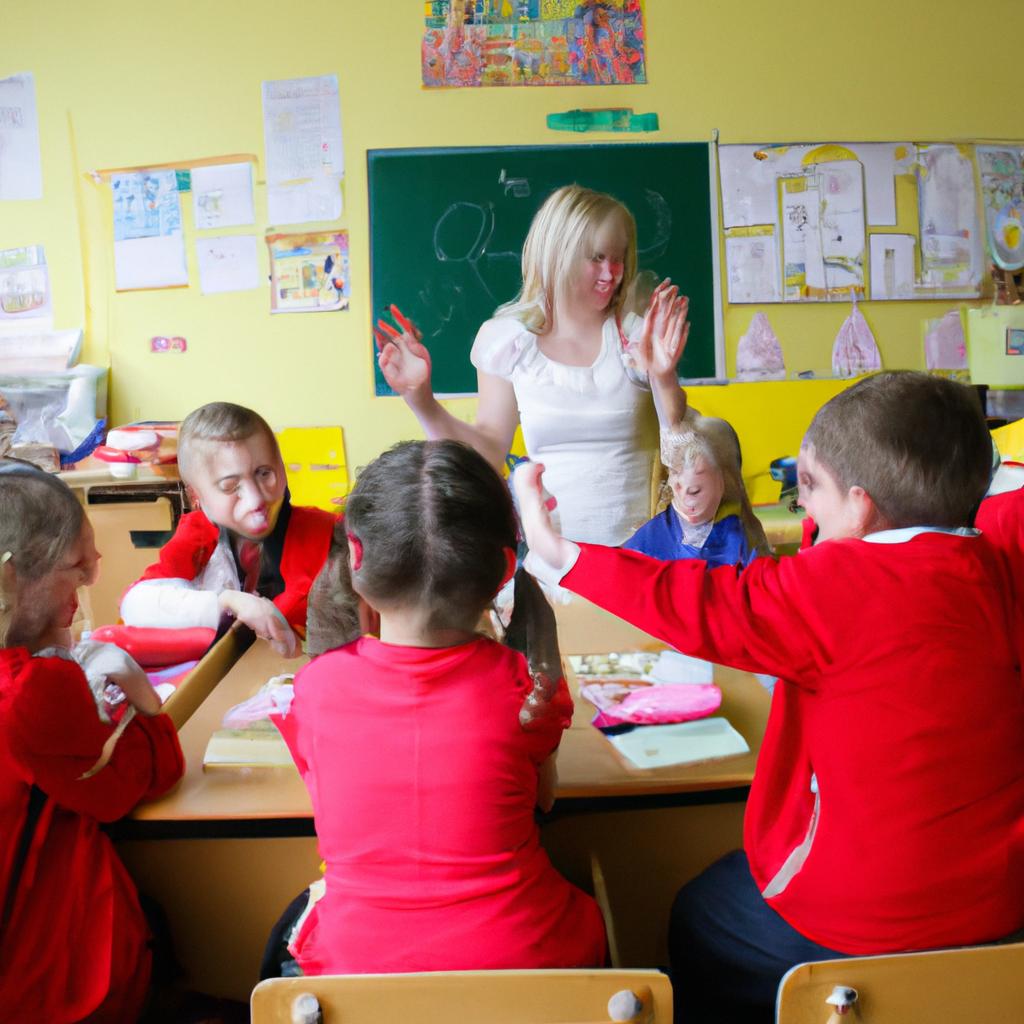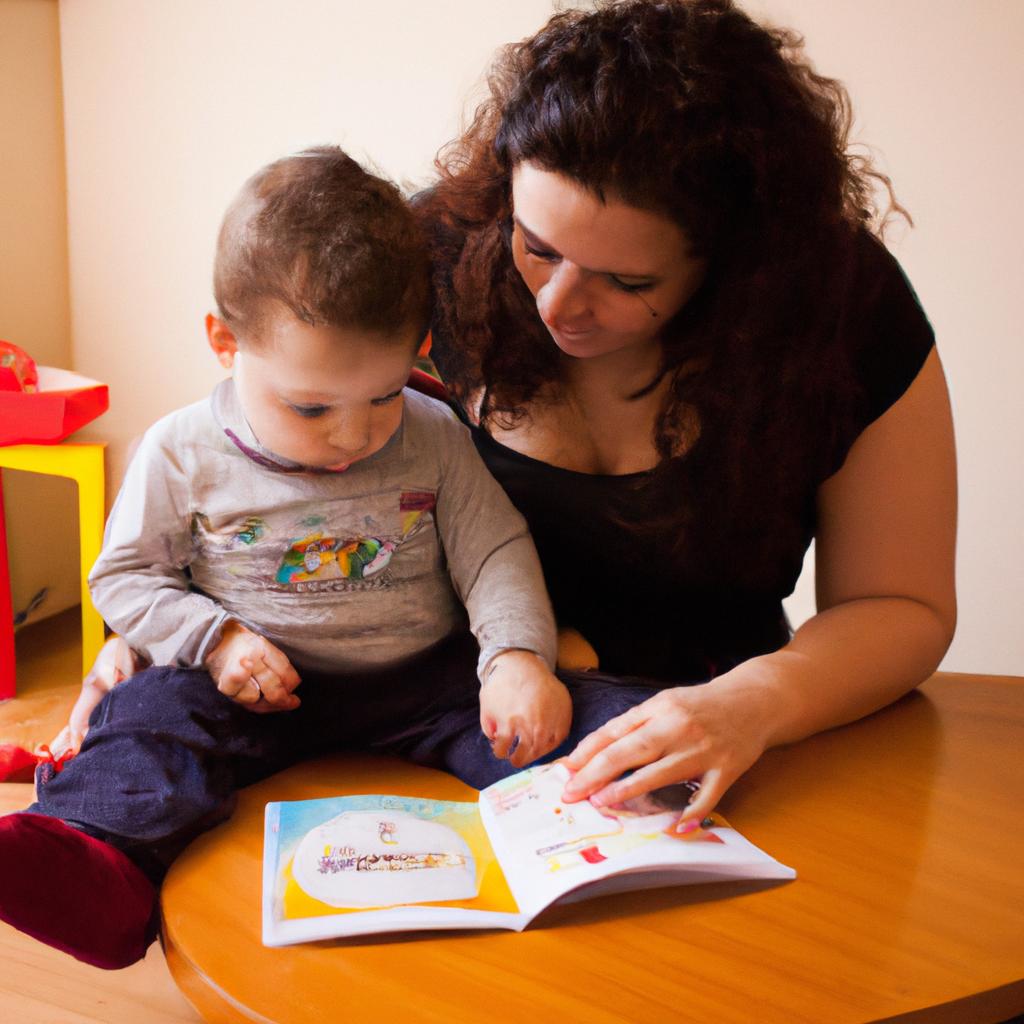Observation in Montessori School: The Role of the Montessori Teacher
In a bustling Montessori classroom, filled with eager and curious young minds, the role of the Montessori teacher takes on a unique significance. Through careful observation, teachers are able to gain valuable insights into each child’s individual needs, interests, and learning styles. This allows them to tailor their instruction and provide an environment that fosters optimal growth and development.
Imagine a scenario where a four-year-old boy named Ethan enters the classroom for the first time. He appears shy and apprehensive as he timidly explores his new surroundings. The Montessori teacher, armed with her keen observational skills, notices this initial hesitation and quickly adapts her approach. She observes how Ethan gravitates towards the sensory materials, particularly those involving touch and texture. Recognizing his preference for tactile experiences, she gently guides him towards activities such as sandpaper letters or geometric solids. As Ethan engages with these materials, his confidence begins to bloom, ultimately leading him on a path of self-discovery and academic success.
By utilizing observations as a powerful tool in the Montessori setting, educators can establish meaningful connections with students like Ethan while simultaneously promoting independent thinking and exploration. In this article , we will explore the role of observation in a Montessori school and how it enhances the educational experience for both teachers and students.
Observation is at the heart of the Montessori method, as it allows teachers to truly understand each child’s unique strengths, weaknesses, and interests. By closely observing their behavior, interactions, and choices within the classroom environment, teachers gain valuable insights into how to best support each child’s learning journey.
In the scenario with Ethan, the teacher’s keen observation skills allowed her to quickly identify his preferences and adapt her approach accordingly. This personalized attention not only helped Ethan feel more comfortable in his new environment but also facilitated his engagement and learning. By providing him with activities that aligned with his tactile learning style, she created an environment where he could thrive and develop confidence in his abilities.
Observation also enables educators to assess student progress accurately and make informed decisions about instruction. By regularly observing students’ work habits and academic achievements, teachers can identify areas where additional support may be needed or where further challenges can be provided. This individualized approach ensures that each child receives appropriate guidance and encouragement at every stage of their development.
Furthermore, observation plays a crucial role in fostering a sense of community within the Montessori classroom. By closely observing students’ social interactions and dynamics, teachers can address any conflicts or challenges promptly. They can guide children towards developing empathy, respect, and effective communication skills by modeling positive behavior themselves.
In conclusion, observation is an essential component of the Montessori teaching philosophy. It empowers teachers to create a nurturing educational environment tailored to each child’s needs while promoting independent thinking and exploration. Through careful observation-based strategies like those used with Ethan, Montessori educators cultivate confident learners who are equipped with essential life skills beyond academics.
The Importance of Observation in Montessori Education
Observation plays a crucial role in the Montessori approach to education. It serves as a powerful tool for both understanding and guiding children’s development within the classroom setting. By closely observing each child, educators gain valuable insights into their unique characteristics, interests, and learning styles. This information enables teachers to tailor their instruction effectively, fostering an environment that supports individual growth and encourages a love for learning.
One example illustrating the significance of observation involves a hypothetical scenario in which a teacher notices that a child consistently gravitates towards activities involving numbers and patterns. Through careful observation, it becomes evident that this particular child possesses an exceptional aptitude for mathematics at an early age. Armed with this knowledge, the teacher can provide appropriate materials and opportunities to nurture the child’s mathematical abilities further.
- Observation allows teachers to identify areas where children may need additional support or intervention.
- It helps create a sense of collaboration between teachers, parents, and students by providing accurate data about each child’s progress.
- Observation promotes empathy and understanding among educators as they witness firsthand the challenges faced by diverse learners.
- It fosters an appreciation for individual differences while reinforcing the importance of inclusivity within the classroom community.
In addition to these benefits, observation also facilitates documentation through tools such as checklists and anecdotal notes. These records capture significant milestones and serve as evidence of academic growth over time. To illustrate how observations are documented efficiently, here is a three-column table showcasing key observations made during different stages of development:
| Age/Stage | Observation | Teacher Action |
|---|---|---|
| 3 years old | Shows interest in sensory activities (e.g., sandpaper letters) | Provides various tactile experiences tailored to letter recognition |
| 4 years old | Demonstrates advanced problem-solving skills in practical life activities | Offers more complex challenges and materials to enhance critical thinking |
| 5 years old | Exhibits a strong sense of independence and self-discipline | Encourages the child’s participation in decision-making processes |
Ultimately, observation serves as a bridge between understanding each child’s unique needs and providing appropriate guidance. By closely observing children within the Montessori classroom, teachers gain valuable insights that inform their instructional strategies and support individual growth.
Transitioning into the subsequent section on “The Montessori Teacher as an Observer,” we delve deeper into how educators actively engage in this role by employing various techniques and methodologies.
The Montessori Teacher as an Observer
Observation plays a pivotal role in Montessori education, enabling the teacher to gain valuable insights into each child’s learning process. By closely observing their students, Montessori teachers can better understand their individual needs and tailor instruction accordingly. This section will explore the important role of the Montessori teacher as an observer, highlighting how observation enhances the educational experience for both the teacher and the student.
To illustrate this point, let us consider a hypothetical scenario where a Montessori teacher observes a student struggling with a specific task. Through careful observation, the teacher notices that the student becomes frustrated when attempting to tie shoelaces independently. The teacher recognizes this as an opportunity for intervention and decides to offer guidance during one-on-one lessons, providing step-by-step instructions until mastery is achieved. This example demonstrates how observation empowers teachers to identify areas where support is needed and provide targeted assistance.
The Montessori teacher’s ability to observe effectively relies on several key practices:
- Maintaining objectivity: Observations should be unbiased and free from personal judgments or preconceptions.
- Documenting observations: Detailed notes enable teachers to track progress over time and make informed decisions about each child’s development.
- Recognizing patterns: Consistently observing allows teachers to identify recurring behaviors or challenges that may require further attention.
- Adapting instructional strategies: By understanding individual learning styles through observation, teachers can adapt their teaching methods for optimal engagement and comprehension.
| Key Practices for Effective Observation |
|---|
| Maintain objectivity |
| Document observations |
| Recognize patterns |
| Adapt instructional strategies |
In summary, effective observation enables Montessori teachers to gain deep insights into their students’ unique strengths and areas for improvement. It equips them with invaluable information necessary for creating tailored learning experiences that meet individual needs. By maintaining objectivity, documenting observations, recognizing patterns, and adapting instructional strategies, they ensure every child receives the support they require to thrive in their educational journey.
Transitioning into the subsequent section, “The Purpose of Observation in the Montessori Classroom,” we will explore how observation serves as a powerful tool for fostering growth and development among students.
The Purpose of Observation in the Montessori Classroom
The Montessori Teacher as an Observer plays a vital role in the Montessori classroom, utilizing observation as a powerful tool to understand and support each child’s unique development. By closely observing the children, the Montessori teacher gains valuable insights into their individual needs, interests, and progress within the prepared environment.
For instance, let us consider a hypothetical case study of a six-year-old boy named Alex who attends a Montessori school. Through careful observation, his teacher notices that he often struggles with concentration during group activities but demonstrates remarkable focus when engaging with hands-on materials in the practical life area. This observation prompts the teacher to adapt her approach by providing more opportunities for independent work using concrete materials, enabling Alex to thrive academically.
Observation allows Montessori teachers to gather essential information about each child’s developmental milestones, strengths, challenges, and learning preferences. To ensure accurate documentation and facilitate systematic observations, these educators employ various techniques and tools:
- Anecdotal Records: Teachers record specific behaviors or incidents observed during classroom interactions.
- Checklists: These provide a structured framework for assessing skills or competencies across different areas of development.
- Time Sampling: Observations are made at regular intervals over designated periods to gain insight into patterns of behavior or engagement.
- Work Samples: Actual examples of student work are collected to assess progress over time.
Through effective observation practices, Montessori teachers create comprehensive profiles for each child in their care. This holistic understanding allows them to tailor instruction according to individual needs while fostering independence and self-directed learning.
Transitioning seamlessly from this section on observation techniques is our next topic – “Observation Techniques and Tools Used by Montessori Teachers.” We will explore how these methods align with Maria Montessori’s educational philosophy and contribute to creating optimal learning environments for young learners.
Observation Techniques and Tools Used by Montessori Teachers
Observation in Montessori School: The Role of the Montessori Teacher
Having explored the purpose of observation in the Montessori classroom, we now turn our attention to the essential role that Montessori teachers play in this process. To illustrate this role, let us consider a hypothetical scenario:
Imagine a Montessori teacher named Ms. Johnson who is observing one of her students, Emily, during a practical life activity. As she quietly watches from a distance, Ms. Johnson notices how Emily carefully pours water into a glass without spilling a drop. She observes Emily’s focused concentration and steady hand movements as she carries out each step of the task. Through this observation, Ms. Johnson gains valuable insights into Emily’s development and learning progress.
The role of the Montessori teacher in observation goes beyond simply watching students at work. It involves several key responsibilities:
-
Creating an environment for independent exploration: A Montessori teacher ensures that the classroom setting allows for autonomy and self-guided learning experiences. By providing an organized space with appropriate materials, they encourage students to independently choose activities based on their interests and developmental needs.
-
Documenting observations: Teachers meticulously record their observations using various techniques such as anecdotal notes or checklists. These records serve as valuable references for understanding individual student progress and identifying areas that may require additional support or intervention.
-
Analyzing data: Once gathered, these observations are carefully analyzed by Montessori teachers to identify patterns, strengths, and areas where further guidance might be needed. This analysis helps inform instructional decisions and enables personalized teaching approaches tailored to each child’s unique learning style.
-
Collaborating with colleagues and parents: Effective communication between Montessori teachers, other staff members, and parents is crucial for creating holistic educational experiences. Sharing observational findings enhances collaboration among stakeholders involved in supporting children’s growth and development.
In recognition of the importance of observation in promoting effective teaching and learning, Montessori teachers employ various tools to facilitate this process. The following table illustrates some commonly used observation techniques:
| Observation Technique | Description |
|---|---|
| Running Record | Detailed narrative account of student behavior and interactions during a specific period |
| Time Sampling | Recording observations at predetermined intervals to capture a snapshot of the child’s activities throughout the day |
| Event Sampling | Focused on particular events or behaviors that are of interest or concern |
| Checklists | Structured lists outlining specific skills or behaviors to be observed and noted |
As we have seen, the role of a Montessori teacher in observation is multifaceted, involving creating an enabling environment, documenting observations, analyzing data, and fostering collaboration. In our next section about “The Benefits of Observation for Montessori Teachers,” we will explore how these practices benefit not only the students but also the teachers themselves as they continue their professional growth and development within the Montessori approach.
The Benefits of Observation for Montessori Teachers
In the previous section, we discussed the various observation techniques and tools used by Montessori teachers to gain insights into their students’ development. Now, let us delve deeper into the role of the Montessori teacher in conducting these observations and utilizing them effectively.
To illustrate this, let’s consider a hypothetical case study. Imagine a Montessori teacher named Ms. Johnson who is observing a three-year-old student named Sarah during her independent work time. Ms. Johnson carefully observes Sarah as she chooses materials from different areas of the classroom, engages with them, and interacts with her peers.
The role of the Montessori teacher during observation can be summarized as follows:
- Maintaining an objective stance: The observer must remain neutral and unbiased while closely watching every aspect of the child’s behavior without imposing any preconceived notions or judgments.
- Documenting observations: It is crucial for teachers to record their observations accurately and efficiently using tools such as checklists, anecdotal notes, or audiovisual recordings.
- Analyzing patterns and identifying needs: Through careful analysis of collected data, Montessori teachers can identify patterns in children’s behavior, strengths, weaknesses, interests, and developmental needs.
- Collaborating with colleagues and parents: Observation findings serve as valuable information for collaborative discussions between teachers, parents, and other professionals involved in supporting the child’s growth.
| Observational Technique | Purpose |
|---|---|
| Anecdotal Notes | Detailed records capturing specific behaviors or incidents observed |
| Time Sampling | Tracking activities at regular intervals to understand engagement levels |
| Checklists | Assessing mastery of specific skills or progress towards learning goals |
The accurate implementation of these techniques enables Montessori teachers to gather comprehensive information about each individual child’s unique learning journey. By recognizing patterns in behavior and assessing developmental milestones, teachers can tailor their approach to meet the specific needs of each student.
Understanding the child’s strengths and challenges allows for personalized interventions that foster growth and development within a supportive educational environment.
Applying Observation Findings in Montessori Education
Having discussed the benefits of observation for Montessori teachers, it is important to explore how these observations can be applied in practice. By closely observing students’ progress and individual needs, Montessori teachers are able to tailor their instruction to meet each student’s unique learning style.
One example that illustrates the significance of observing student progress and individual needs is the case of Sarah, a five-year-old student who was struggling with letter recognition. Through regular observation, her Montessori teacher noticed that she often became frustrated during language activities and showed little interest in reading. This prompted the teacher to dig deeper into Sarah’s specific challenges by conducting additional assessments and documenting her behaviors. The teacher discovered that Sarah had difficulty differentiating between similar letters like ‘b’ and ‘d,’ which hindered her ability to read fluently. Armed with this knowledge, the teacher implemented targeted interventions such as using tactile materials and providing extra practice opportunities specifically designed to address Sarah’s struggles. Over time, Sarah’s progress improved significantly as she gained confidence in recognizing letters accurately.
Observation allows Montessori teachers to gain valuable insights into their students’ individual needs, enabling them to provide tailored support and guidance. Here are some key ways in which observation facilitates understanding and response:
- Identifying areas of strength and weakness: Close observation helps identify not only areas where students excel but also areas where they may struggle or need extra support.
- Adapting instruction methods: By carefully observing how students learn best, teachers can adapt their instructional strategies accordingly, catering to diverse learning styles within the classroom.
- Promoting independent learning: Observation enables teachers to recognize when a student is ready for more advanced tasks or when they require additional scaffolding.
- Fostering positive relationships: Regular observation builds trust between teachers and students, creating an environment conducive to open communication and mutual respect.
To further illustrate the significance of observation in Montessori education, consider the following table showcasing how different observations can inform instructional decisions:
| Observation | Findings | Instructional Decision |
|---|---|---|
| Student A | Struggles with fine motor skills | Provide activities to strengthen hand-eye coordination. |
| Student B | Demonstrates a strong interest in nature | Integrate nature-related materials and experiences into lessons. |
| Student C | Excels at problem-solving tasks | Assign more complex puzzles and challenges to encourage critical thinking. |
| Student D | Prefers working alone rather than in groups | Create opportunities for independent work while still fostering collaboration when appropriate. |
In conclusion, observing students’ progress and individual needs is an integral part of effective Montessori teaching. By carefully documenting behaviors, identifying areas of strength and weakness, adapting instruction methods, promoting independence, and building positive relationships, Montessori teachers are able to provide personalized guidance that supports each student’s unique learning journey. Through these observations, they gain valuable insights that inform their instructional decisions and ultimately contribute to the overall success and growth of their students.


